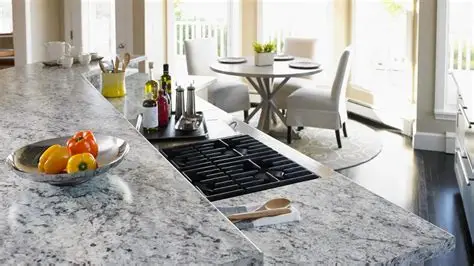Introduction: Igneous Rocks Beneath the Waves
The Earth’s ocean floor is a geological wonder, composed mainly of igneous rock formed by volcanic activity. While many people associate the word “igneous” with granite, the rock that dominates much of Earth’s continental crust, the seafloor tells a different story. The answer to the question is basalt—a dark, fine-grained igneous rock.
In this article, we’ll compare basalt with granite, understand why basalt is more prevalent beneath our oceans, and explore how granite remains one of the most valued materials on land for both geology and design.

Basalt vs. Granite: A Geological Overview
Basalt
- Found mainly in oceanic crust
- Fine-grained due to rapid cooling of lava at or near the surface
- Rich in iron and magnesium minerals
- Dark in color, typically black or dark gray
Granite
- Found mainly in continental crust
- Coarse-grained due to slow cooling of magma deep underground
- Rich in quartz, feldspar, and mica
- Light-colored with visible crystals
- For more details, see: How can a large block of granite form layers like an onion?

Why Basalt Dominates the Ocean Floor
The ocean floor is shaped by seafloor spreading at mid-ocean ridges. As tectonic plates pull apart, magma rises from the mantle, cools quickly in seawater, and solidifies into basalt.
Granite, by contrast, forms deep within the continental crust from slow-cooling magma and is not a product of this rapid underwater volcanic activity.
Characteristics of Granite That Set It Apart
Even though granite is not common on the ocean floor, it remains geologically and commercially important. Key characteristics of granite include:
- Exceptional durability and compressive strength
- Low porosity (though sealing is still recommended)
- Aesthetic versatility in white granite countertops and black granite countertops
Granite is also the primary material for high-end kitchen and bathroom countertops, offered in a wide range of colors and patterns through suppliers like the Aardwolf granite countertop collection.
From Quarry to Kitchen: Granite in Modern Design
While basalt is great for oceanic crust, granite shines in home interiors. Using specialized tools such as kerb stone handling solutions ensures granite slabs arrive safely at fabrication shops and installation sites.
Homeowners often ask:
- Are granite countertops better than quartz countertops?
- Which is more durable: granite or quartz countertops?
Weathering and Durability
In nature, granite resists weathering much better than basalt, thanks to its high quartz content. Still, cracks can form over long periods:
Indoors, with proper sealing, granite countertops can last decades without losing their polished beauty.
The Ocean Floor’s Geologic Diversity
While basalt is the main igneous rock under the oceans, other materials exist:
- Gabbro in deeper layers of oceanic crust
- Sediments deposited over basalt, including limestone and shale
- Rare intrusions of granite in certain tectonic settings, usually near continental margins
Conclusion: Basalt Rules the Seas, Granite Rules the Home
Basalt forms the backbone of the ocean floor because of its volcanic origin and rapid cooling process at spreading ridges. Granite, though rare in oceanic settings, dominates continental crust and plays a starring role in construction, architecture, and design.
From undersea ridges to luxury kitchens, the contrast between basalt and granite highlights the geological diversity of our planet. Both rocks have their place—one deep beneath the oceans, the other as the crown jewel of interior surfaces.

